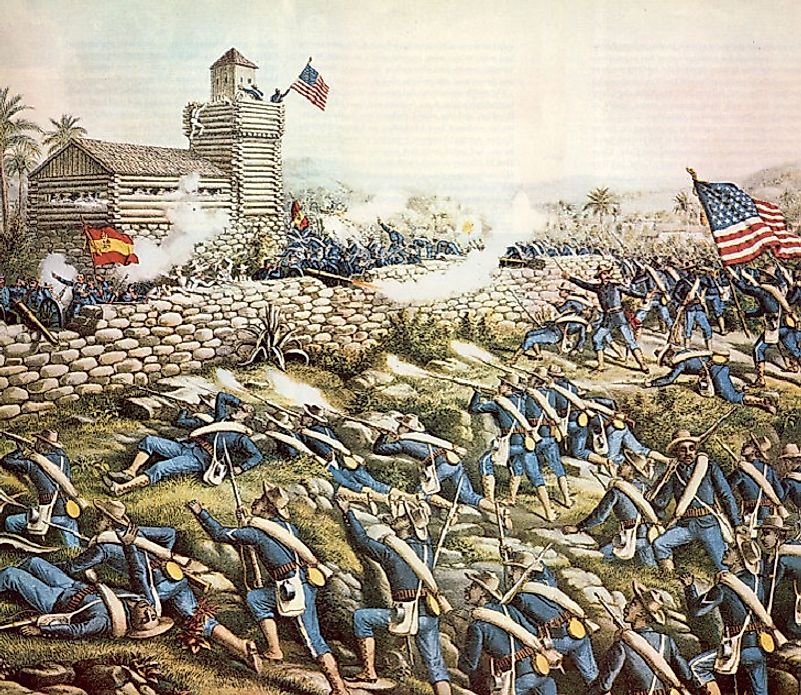The Battle Of San Juan Hill (Spanish-American War)

5. Background
The battle took place on July 1st, 1898, on the San Juan Heights in Cuba. It was one of the most important battles to take place during the Spanish-American War. The Spanish American War came as a result of American intervention during the Cuban War for Independence, Cuba up to that time being a Spanish territory.
4. MAKEUP OF THE FORCES
Before the battle, the Spanish General Arsenio Linares called for 760 Spanish troops to defend the Heights, but did not adequately reinforce the position. The Spanish fortifications on the hilltops were not well equipped for exchanging fire, and the lack of defense would be devastating once their enemies’ troops started scaling the hills. On the American side, General William Shafter was in charge of the 15,000-man strong Fifth Army Corps, with Joseph Wheeler Jacob Kent, Henry Lawton, and Charles Sumner serving under him. However, only about 8,000 Americans were actually involved in the battle, as Lawton's division was sent north, to the Spanish fortress of El Caney, and did not return in time to aid in the battle. The Cuban troops present there fighting alongside the Americans totaled to about 3,000 soldiers.
3. DESCRIPTION OF THE BATTLE
General Shafter's plan was to split his remaining army and attack both San Juan and Kettle Hill concurrently. A reconnaissance group was sent out first in a hot air balloon, itself suffering heavy losses from enemy fire. Brigadier Generals Kent and Sumner readied their troops following scouting reports, but received no further orders from either Shafter or Wheeler, leaving the soldiers sitting ducks amidst Spanish fire in the areas that would later be named "Hell's Pocket." After a period of waiting and some advances, Captain John Bigelow, Jr. ordered his Buffalo Soldiers into a charge on San Juan Hill, closely followed by the African-American 24th Infantry Regiment and other U.S. Army infantry. On Kettle Hill, the attack was led by the 1st United States Volunteer Cavalry, more commonly known as the Rough Riders. A final charge, along with machine gun fire, forced the Spanish forces into retreat and, although they launched a counter-attack later that day, it was easily beaten back with the rapid fire of the Gatling Gun.
2. OUTCOMES
The battle was a victory for the Americans, although they suffered almost five times as many losses as the Spanish. Although the Spanish did lose about a third of their forces, they did not yield many prisoners. After the battle, the United States military decided to modernize their equipment further, switching from the older Springfield rifles and Mauser rifles, which were used against the Spanish soldiers, to a newly developed M1903 Springfield (a.k.a. .30-ought- 06). The American media immediately latched onto the story, heavily promoting Theodore Roosevelt and the Rough Riders, even though most of the fighting on the American side was carried out by the Buffalo Soldiers of the 24th Infantry and 10th Cavalry.
1. Historical Significance and Legacy
During this battle, and much of the rest of the war, the combined United States’ and Cuban forces proved numerically and militarily superior, and influenced the eventual collapse of the Spanish Empire’s claims in the region. At the end of the war, Spain agreed to peace, and signed the 1898 Treaty of Paris. The treaty ceded possession of Puerto Rico, the Philippines, and Guam to the U.S. The treaty also gave Americans temporary control over Cuba. A war of a new era, his battle was one of the first uses of American machine gun fire, specifically the Gatling Gun, which provided significant cover and support for American assaults on both San Juan and Kettle Hills. Although the ‘Rough Riders’ of the U.S. 1 st Volunteer Calvary, including soon-to-be-President Teddy Roosevelt, Teddy Roosevelt, gained some of the most lasting, widespread acclaim for their actions in the battle, it was in fact another Calvary unit, the ‘Buffalo Soldiers’, who were crucial to the battle’s outcomes, for their valiant efforts on Kettle Hill. The Buffalo Soldiers were an African-American unit of Regulars of the U.S. 10th Calvary, and their taking of Kettle Hill was one of the most significant events in the battle’s outcomes. In fact, multiple members of the unit received the highest U.S. military honor, the Medal of Honor, for their valiant efforts in the fight.











